Muhammad Iqbal Rochman
Indoor/Outdoor Spectrum Sharing Enabled by GNSS-based Classifiers
Sep 30, 2025Abstract:The desirability of the mid-band frequency range (1 - 10 GHz) for federal and commercial applications, combined with the growing applications for commercial indoor use-cases, such as factory automation, opens up a new approach to spectrum sharing: the same frequency bands used outdoors by federal incumbents can be reused by commercial indoor users. A recent example of such sharing, between commercial systems, is the 6 GHz band (5.925 - 7.125 GHz) where unlicensed, low-power-indoor (LPI) users share the band with outdoor incumbents, primarily fixed microwave links. However, to date, there exist no reliable, automatic means of determining whether a device is indoors or outdoors, necessitating the use of other mechanisms such as mandating indoor access points (APs) to have integrated antennas and not be battery powered, and reducing transmit power of client devices which may be outdoors. An accurate indoor/outdoor (I/O) classification addresses these challenges, enabling automatic transmit power adjustments without interfering with incumbents. To this end, we leverage the Global Navigation Satellite System (GNSS) signals for I/O classification. GNSS signals, designed inherently for outdoor reception and highly susceptible to indoor attenuation and blocking, provide a robust and distinguishing feature for environmental sensing. We develop various methodologies, including threshold-based techniques and machine learning approaches and evaluate them using an expanded dataset gathered from diverse geographical locations. Our results demonstrate that GNSS-based methods alone can achieve greater accuracy than approaches relying solely on wireless (Wi-Fi) data, particularly in unfamiliar locations. Furthermore, the integration of GNSS data with Wi-Fi information leads to improved classification accuracy, showcasing the significant benefits of multi-modal data fusion.
Indoor Sharing in the Mid-Band: A Performance Study of Neutral-Host, Cellular Macro, and Wi-Fi
Jun 05, 2025Abstract:Indoor environments present a significant challenge for wireless connectivity, as immense data demand strains traditional solutions. Public Mobile Network Operators (MNOs), utilizing outdoor macro base stations (BSs), suffer from poor signal penetration. Indoor Wi-Fi networks, on the other hand, may face reliability issues due to spectrum contention. Shared spectrum models, particularly the Citizens Broadband Radio Service (CBRS) utilized by private 4G/5G networks, have emerged as a promising alternative to provide reliable indoor service. Moreover, these private networks are equipped with the neutral-host (NH) model, seamlessly offloading indoor MNOs' traffic to the private CBRS network. This paper presents a comprehensive, in-situ performance evaluation of three co-located technologies utilizing mid-bands spectrum (1-6 GHz)--a CBRS-based NH network, public MNO macro networks, and a Wi-Fi 6 network--within a large, big-box retail store characterized by significant building loss. Our analysis demonstrates: (i) the NH network provides superior indoor coverage compared to MNO macro, requiring only six CBRS devices (CBSDs)--versus 65 Access Points (APs) for enterprise Wi-Fi--to achieve full coverage, with a median building loss of 26.6 dB ensuring interference-free coexistence with outdoor federal incumbents; (ii) the NH network achieves substantial indoor throughput gains, with per-channel normalized throughput improvements of 1.44x and 1.62x in downlink (DL), and 4.33x and 13x in uplink (UL), compared to 4G and 5G macro deployments, respectively; (iii) the NH deployment achieves a median indoor aggregated physical (PHY)-layer DL throughput gain of 2.08x over 5G macro deployments indoors, despite utilizing only 40 MHz of aggregated bandwidth compared to 225 MHz for 5G macro; and (iv) the NH deployment also outperforms Wi-Fi in application-layer HTTP DL performance by 5.05x.
Data Driven Environmental Awareness Using Wireless Signals for Efficient Spectrum Sharing
Oct 17, 2024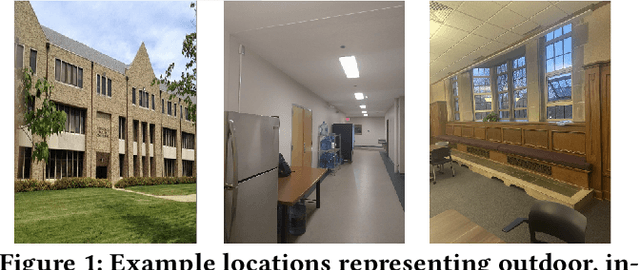
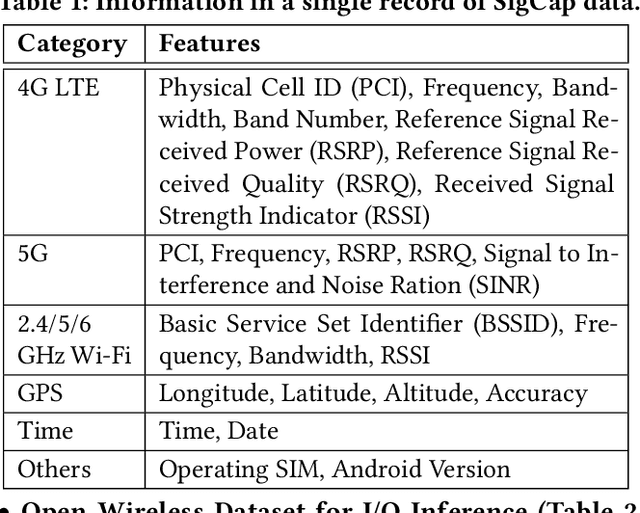
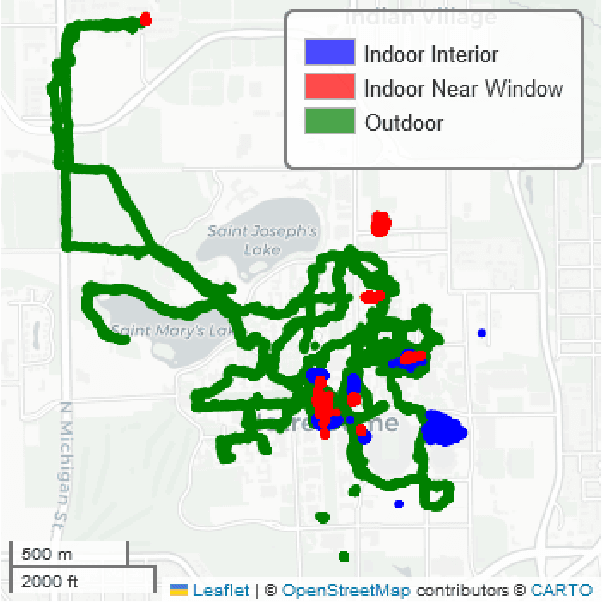
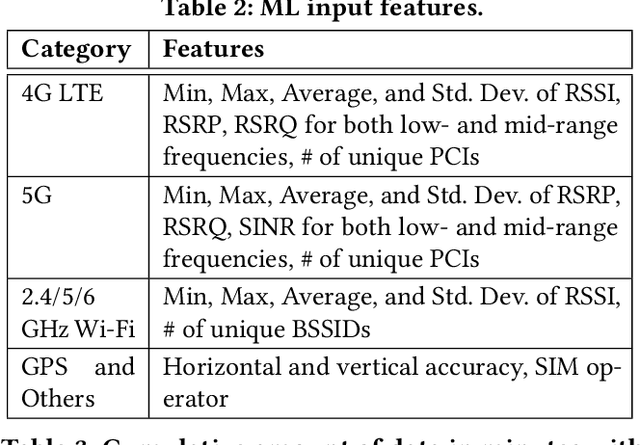
Abstract:Robust classification of the operational environment of wireless devices is becoming increasingly important for wireless network optimization, particularly in a shared spectrum environment. Distinguishing between indoor and outdoor devices can enhance reliability and improve coexistence with existing, outdoor, incumbents. For instance, the unlicensed but shared 6 GHz band (5.925 - 7.125 GHz) enables sharing by imposing lower transmit power for indoor unlicensed devices and a spectrum coordination requirement for outdoor devices. Further, indoor devices are prohibited from using battery power, external antennas, and weatherization to prevent outdoor operations. As these rules may be circumvented, we propose a robust indoor/outdoor classification method by leveraging the fact that the radio-frequency environment faced by a device are quite different indoors and outdoors. We first collect signal strength data from all cellular and Wi-Fi bands that can be received by a smartphone in various environments (indoor interior, indoor near windows, and outdoors), along with GPS accuracy, and then evaluate three machine learning (ML) methods: deep neural network (DNN), decision tree, and random forest to perform classification into these three categories. Our results indicate that the DNN model performs the best, particularly in minimizing the most important classification error, that of classifying outdoor devices as indoor interior devices.
Machine Learning enabled Spectrum Sharing in Dense LTE-U/Wi-Fi Coexistence Scenarios
Mar 18, 2020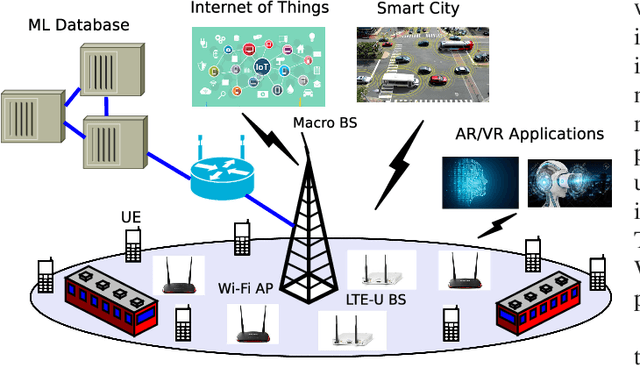
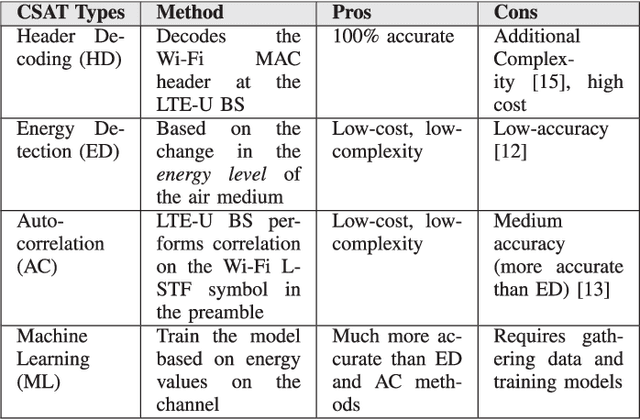
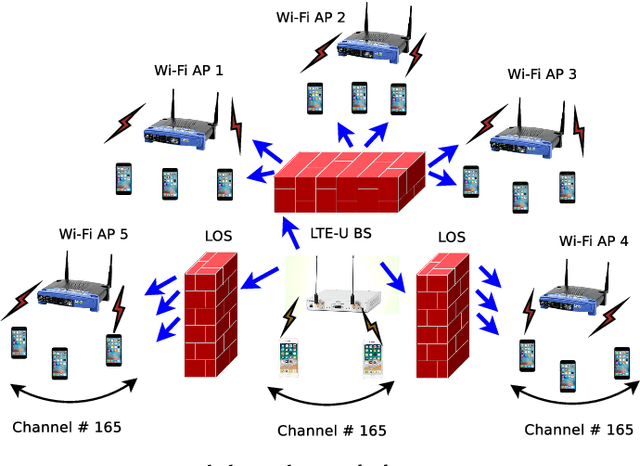
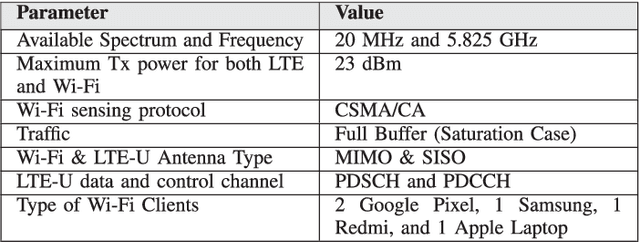
Abstract:The application of Machine Learning (ML) techniques to complex engineering problems has proved to be an attractive and efficient solution. ML has been successfully applied to several practical tasks like image recognition, automating industrial operations, etc. The promise of ML techniques in solving non-linear problems influenced this work which aims to apply known ML techniques and develop new ones for wireless spectrum sharing between Wi-Fi and LTE in the unlicensed spectrum. In this work, we focus on the LTE-Unlicensed (LTE-U) specification developed by the LTE-U Forum, which uses the duty-cycle approach for fair coexistence. The specification suggests reducing the duty cycle at the LTE-U base-station (BS) when the number of co-channel Wi-Fi basic service sets (BSSs) increases from one to two or more. However, without decoding the Wi-Fi packets, detecting the number of Wi-Fi BSSs operating on the channel in real-time is a challenging problem. In this work, we demonstrate a novel ML-based approach which solves this problem by using energy values observed during the LTE-U OFF duration. It is relatively straightforward to observe only the energy values during the LTE-U BS OFF time compared to decoding the entire Wi-Fi packet, which would require a full Wi-Fi receiver at the LTE-U base-station. We implement and validate the proposed ML-based approach by real-time experiments and demonstrate that there exist distinct patterns between the energy distributions between one and many Wi-Fi AP transmissions. The proposed ML-based approach results in a higher accuracy (close to 99\% in all cases) as compared to the existing auto-correlation (AC) and energy detection (ED) approaches.
 Add to Chrome
Add to Chrome Add to Firefox
Add to Firefox Add to Edge
Add to Edge